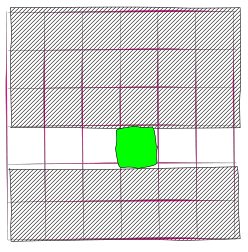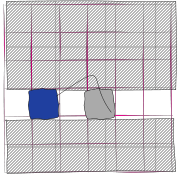Joy of OCaml - Part II
- let keyword
- User-defined types
- Record types
- Basic containers
- More involved code
- Move the focus inside the grid
In the second part I explain some more language features and code.
let keyword
We start with this keyword again as this tripped me up. Moreover one does not proceed much further without understanding the semantics of this keyword.
(let table = Hashtbl.create 10 in
Hashtbl.add table "functional" ["practical";"utilitarian"];
Hashtbl.add table "side-effect" ["outcome";"consequence"];
table )
;;let choose_randomly_hashtbl table (word : string) =
let n0 = Hashtbl.find table word in
let n1 = Random.int (List.length n0) in
let n2 = List.nth n0 n1 in
n2
;;choose_randomly_hashtbl returns randomly one of the values from the list corresponding to the key . And we see that n0, n1 and n2 are used after they are defined one by one. This should give a clearer idea about let’s semantics.
User-defined types
As the name implies a UDF is a custom type defined by the user.
type x = cell list;;Record types
A record type is a step further. It identifies each constituent part of the type by a name identifier like this.
type cell = { alive : bool ; column : int ; row : int }
;;Nested pattern matching Record types
I plan to write about pattern matching concepts in another installment of this series as that is deeper than what would fit in one paragraph.
| {gamegrid = line :: above},{gamegrid = below} -> (The third line in the up function shown below matches the head(line) of the list and the tail(above) of the list. It is nested because the pattern matches the constituent part identified by a name inside a record type. gamegrid is the name identifier of a grid defined by this code. It is a grid made of a list of lists of cell which is another record type.
type grid = {gamegrid : cell list list}
;;Partial updates of Record types
In this function G, which is of type gridzipper is updated partially. above and below are not updated. The keyword with enables us to do this.
let left g =
match g.left with
[] -> None
| hd::tl -> let newgridzipper = { g with focus = hd; left = tl; right = g.right @ [g.focus] } in
Some(newgridzipper)
;;Basic containers
As I understand it these are library extensions. We have to install those libraries we require. So, for example, CCList enables us to create a mxn list of lists easily.
This is how I used it.
#require "containers";;
let makegrid = CCList.init 2 ( fun i -> (CCList.init 2 (fun j -> { alive = true; column = j;row = i })) );;This create a 2x2 grid which is a list of lists.`List seems to be the workhorse of functional programming languages.
More involved code
Let us use the record types and UDF’s to code a grid using the zipper pattern which is a functional way of coding a grid. The code should serve as a foundation for a game of life representation in the future.
It should be pointed out that none of these functions mutate any data structure. So there is no side-effect. As you see it takes some effort to shed our memory of imperative mutable code. It is hard at the beginning but seems quite natural now.
Some of the following functions are my OCaml port of existing Haskell code. Given that I am not an OCaml expert, this code is far more verbose than the equivalent Haskell code My Haskell chops were not enough and I turned to the IRC for much needed advice.
The code focuses on a cell like this picture shows. There are areas above,below, to the left and to the right. We move over this grid. The focus is the green square.

type cell = { alive : bool ; column : int ; row : int }
;;type cell = { alive : bool ; column : int ; row : int }
;;type grid = {gamegrid : cell list list}
;;type gridzipper =
{ above : grid
; below : grid
; left : cell list
; right : cell list
; focus : cell }let focuscell celllist n =
let rec loop acc n l =
match l,n with
| hd :: tl,n when n > 0 -> loop (hd :: acc) (n - 1) tl
| [],_ -> None
| hd :: tl,0 -> Some (acc, hd, tl)
in loop [] n celllist
;;let gridfocus x y g =
let a = focuscell g x in
match a with
| Some(before, line , after) -> (
let b = focuscell line y in
match b with
Some (left , focus, right) ->
(
(let above = { gamegrid = before } in
let below = { gamegrid = after} in
Some(
{ above
; below
; left
; right
; focus }
)
)
)
| None -> None
)
| None -> None
;;Move the focus inside the grid

The left function moves the focus to the left. Similarly the other functions shift the focus to other grids cells.
let left g =
match g.left with
[] -> None
| hd::tl -> let newgridzipper = { g with focus = hd; left = tl; right = g.right @ [g.focus] } in
Some(newgridzipper)
;;let right g =
match g.left with
[] -> None
| hd::tl -> let newgridzipper = { g with focus = hd; left = [g.focus]; right = tl } in
Some(newgridzipper)
;;(*pattern-matches on the list (of lists) , which should be non-empty, and introduces two bindings,
line for the head, and above for the tail.*)
let up g =
match g.above,g.below with
| {gamegrid = line :: above},{gamegrid = below} -> (
let below' = (List.rev g.left) :: ([g.focus] @ g.right) :: below in
let a = focuscell line (List.length g.left) in
match a with
Some (left, focus, right) ->
let above = { gamegrid = above } in
let below = { gamegrid = below'} in
Some{ above
; below
; left
; right
; focus }
|None ->
None
)
|({gamegrid=[]},_) -> None
;;let down g =
match g.below,g.above with
| {gamegrid = line :: below},{gamegrid = above} -> (
let above' = (List.rev g.left) :: ([g.focus] @ g.right) :: above in
let a = focuscell line (List.length g.left) in
match a with
Some (left, focus, right) ->
let above = { gamegrid = above } in
let below = { gamegrid = above'} in
Some{ above
; below
; left
; right
; focus }
|None ->
None
)
| ({gamegrid=[]},_)-> None
;;#require "containers";;
let makegrid = CCList.init 2 ( fun i -> (CCList.init 2 (fun j -> { alive = true; column = j;row = i })) );;Function that tests if the focus stays within the grid. None signifies an exceptional movement outside.
let grid = makegrid in
let gf = gridfocus 0 1 grid in
match gf with
| Some(gf) ->
Printf.printf "Focus is on [ %B %d %d ]" gf.focus.alive gf.focus.column gf.focus.row;left gf
| None -> Printf.printf "No focus";gf
;;Another Function that tests focuscell, a lower-order function.
let grid = makegrid in
let fc = focuscell grid 2 in
match fc with
| Some(before, line , after) -> Printf.printf "Focus is on [ %B %d %d ]" (List.nth line 0).alive (List.nth line 0).column (List.nth line 0).row
| None -> Printf.printf "No focus"
;;References :
- Huet, Gerard (September 1997). “Functional Pearl: The Zipper”
